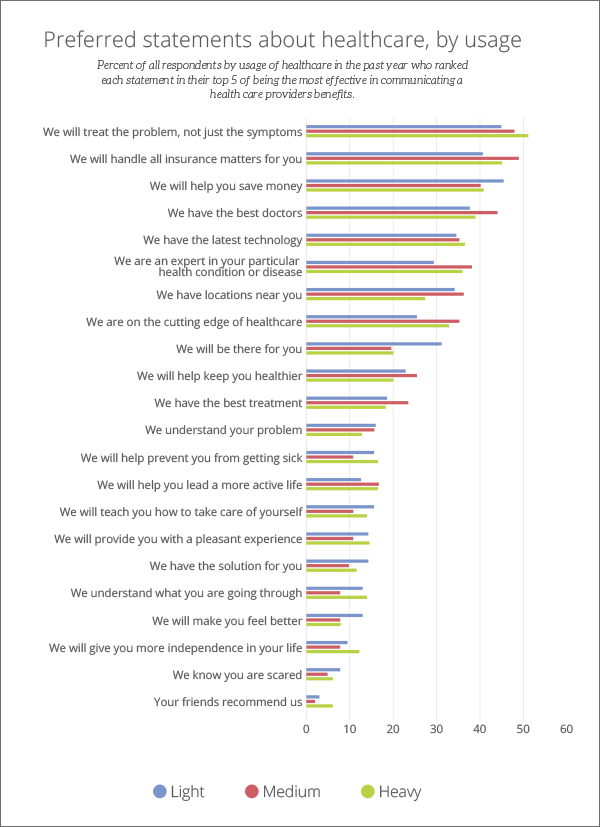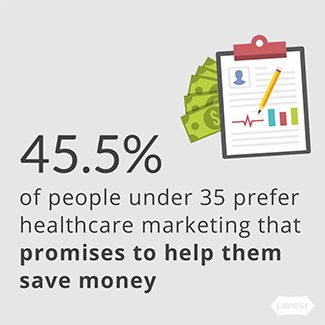Need fresh thinking? Help is a few keystrokes away.
Should a Person's Health Determine How You Market to Them?
This article is a brief abstract of our exclusive study that takes the guesswork
out of healthcare advertising and marketing.
Download the complete 2017 Southwest Healthcare Marketing Report
Wouldn’t it be great to know how a person’s health might affect their response to healthcare marketing and advertising? Would a healthy person prefer different marketing messages than someone who is sick?
To determine this, we asked respondents how often they accessed specific healthcare services in the past year. We inquired about the number of times they performed each of the following in the previous 12 months:
- Visited emergency room
- Visited urgent care center
- Visited primary care doctor
- Visited specialist
- Overnight stay in a hospital
- Had surgery or similar procedure
- Had X-rays or other types of imaging performed
- Had blood, urine or other lab tests performed
For purposes of this study, we identified light usage as 5 or fewer medical visits during the past year; medium, 6–9 visits; and heavy, 10+ visits. The data provides useful insights for segmenting consumers based upon how often they interface with businesses offering healthcare services.
All three groups (light, medium and heavy healthcare users) had a different top preference for their favored health statement. Light users chose “We will help save you money.” Medium users selected “We will handle all insurance matters for you.” The heaviest users preferred “We will treat the problem, not just the symptoms.” Although each group chose a different favorite, all three statements were ranked highly by the three groups, and the variances are within the margin of error of +/- 4.4%.
 Despite the closeness of the numbers, a more detailed look at the data reveals noteworthy trends that can assist health insurance companies with marketing to consumers who access healthcare sparingly and, conversely, might help hospitals and physicians recruit patients who have shown a high propensity of interfacing with healthcare practitioners.
Despite the closeness of the numbers, a more detailed look at the data reveals noteworthy trends that can assist health insurance companies with marketing to consumers who access healthcare sparingly and, conversely, might help hospitals and physicians recruit patients who have shown a high propensity of interfacing with healthcare practitioners.
This gets at an important question for healthcare companies: Do you want customers who have shown a history of frequent access to healthcare services, or do you desire healthier customers who do so sparingly?
The chart above shows that heavy healthcare users prefer the least common statements much more than light or medium users. Compared to light and medium healthcare users, heavy users show marked preferences for “Your friends recommend us,” “We will give you more independence in your life” and “We understand what you are going through.”
Perhaps the most interesting data point here is how high the light healthcare users ranked “We will be there for you.” Light users ranked this more than 11 percentage points higher than medium or heavy users of healthcare providers. We believe this is because the statement “We will be there for you” speaks uniquely about the future. It doesn’t say that we “are” there for you. It looks forward: we “will be” there for you. This is a reassuring message for people who are mostly healthy as demonstrated by their history of rarely touching the healthcare system.
This may be related to the same group (light users) ranking two other statements much lower than medium or heavy users: “We are an expert in your particular health condition or disease” and “We are on the cutting edge of healthcare.” It seems clear that the healthier you are, the less receptive you will be to messages that emphasize current needs.
BIO: Stephen Heitz is LAVIDGE’s Managing Director, Interactive. Tim Trull is the agency’s Managing Director, Strategy.


